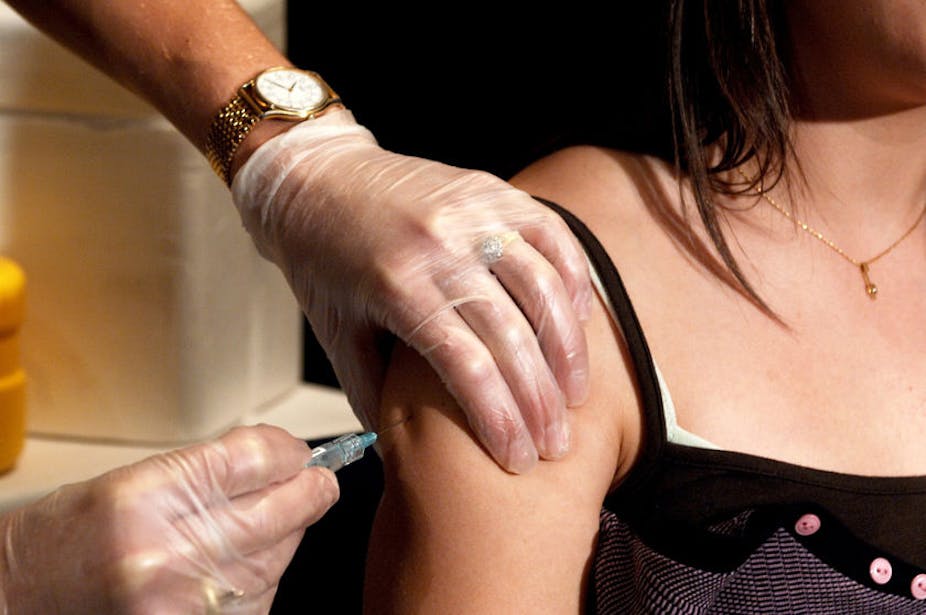The human papillomavirus (HPV) vaccine has attracted attention in the past week for two contradictory reasons: the Japanese government has withdrawn its recommendation for the shot, while public health officials in the United States have attributed a massive drop in the prevalence of the virus among teenage girls to its use.
The Japanese government’s decision is the result of 1,968 reported cases of possible side effects, 43 of which have been examined by a health ministry task force. Since 2010, 3.28 million Japanese women have received the human papillomavirus vaccination.
In the United States, on the other hand, there’s good news with virus thought to be half as common as it used to be, despite only about a third of young women receiving the full vaccine course of three shots.
So, what are we to make of the vaccine? Here are answers to four common questions about it, based on a research paper I recently published with two co-authors.
Does the vaccine prevent infection with the virus?
Both the human papillomavirus vaccines (Gardasil and Cervarix) have been shown to reduce the virus infection rate by over 90%. This reduction is maintained for at least five years.
The catch (and there’s always a catch) is that for the vaccine to be this effective, it has to be given to people who have not been exposed to the virus.
This is why the vaccine is given to 12 to 13-year-olds in Australia and 14 to 19-year-olds in the United States.
Will the vaccine cause a rise in other HPV types?
The human papillomavirus vaccines available in Australia target two (types 16 and 18) of the 15 high-risk virus strains associated with cancer.
Questions have been asked about whether one or more of the remaining 13 cancer-causing virus types will become more common to “fill the gap” left by their reduction.
Clinical trials have shown that both HPV vaccines provide significant protection against five other oncogenic types: 31, 39, 45, 59, and 86. And the Cervarix vaccine also protects against types 33 and 52.
The vaccine’s strength and duration of effect on other non-vaccine HPV types is still being studied.
Does the vaccine prevent cervical cancer?
This is a harder question to answer because human papillomavirus vaccines have only been widely used in Australia since 2007, and internationally since 2006.
It takes between 10 and 20 years from initial infection to the development of cancer. So the direct effect of the vaccination on cervical cancer rates is currently difficult to assess.
But we can glean an effect by looking at the early warning signs of cervical cancer – pre-cancerous lesions called cervical intraepithelial neoplasia (CIN). CIN grade 2 and grade 3 lesions are considered good surrogate markers of cervical cancer because they’re likely to progress to disease 5% and 12% of the time, respectively.
The vaccine reduces these two grades of pre-cancerous lesion by over 99%. And the two HPV types covered by the vaccine are linked to approximately 70% of cervical cancers.
This suggests that a significant decline in cervical cancer will be observable within the next decade. Human papillomavirus infection has also been linked to a number of other cancers such as those of the penis (40% are HPV-associated), vulva or vagina (40%), anus (90%), mouth (3%) and oropharynx (12%).
Is the vaccine safe?
This is probably the most often asked question due, in part at least, to certain (online) organisations using scare tactics against the vaccine (particularly Gardasil).
Like any medical procedure, these vaccines can have side effects. But these are overwhelmingly (more than 93%) minor, and are largely injection site reactions (redness, swelling and pain where the injection was given).
Some other minor self-limiting reactions, which go away without treatment, such as fainting, headache and nausea have also been reported.
Clinical trials involving over 44,000 women showed no differences in serious side effects between the human papillomavirus vaccines and control groups. But monitoring the safety of the vaccines doesn’t stop when these trials are finished. Post-marketing surveillance continues to examine possible vaccine side effects.
It’s sometimes claimed that the human papillomavirus vaccine is associated to premature death. These claims are inevitably linked to reports of deaths on the US Vaccine Adverse Event Reporting System (VAERS). As this is an open system where any member of the public can enter information, it’s difficult to analyse such claims without further investigation.
When such reported deaths are investigated, they are found to not occur any more in vaccinated people than in those who haven’t been vaccinated.
There’s also no evidence of a link between human papillomavirus vaccination and autoimmune conditions.
And for the future…
The rapidly growing body of research from fields including immunology, virology, public health and epidemiology, among others, should help the community, including doctors and parents, to be confident about the benefits of the human papillomavirus vaccine.
These benefits far outweigh its risks, and mechanisms are in place to continue monitoring any future adverse events.

